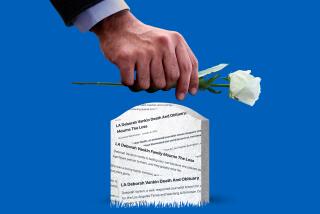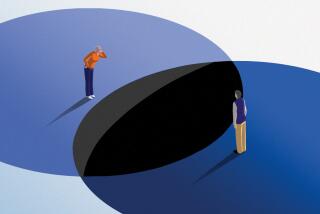UMGTN CMGVP TLGE RVGB : (The Solution to This Headline Is at Bottom of Story)
- Share via
In the end, it took a cryptographer to solve the mystery from the crypt.
The puzzle was a 47-year-old coded message from the grave concocted by a British psychologist who hoped to prove he could communicate with the living after his death.
The solution came from a Topanga Canyon computer scientist who used a code of his own to crack the secret cipher that confounded scholars--and eluded clairvoyants--around the globe.
It took psychologist Robert H. Thouless months to devise his cipher using paper and pencil.
But it took scientist James J. Gillogly only hours to decode it using a laptop computer.
Thouless was a Cambridge University professor best known in this country for his 1974 psychology book “How to Think Straight.” In the years before his death in 1984 at age 90, Thouless spent much of his time thinking of ways to prove that there is life in the beyond.
Communication with the dead was the obvious answer. But how?
Asking dying people to leave messages sealed in an envelope was one way. Later, mediums could conduct seances in hopes of contacting the dead person and learning the message. But Thouless realized that skeptics would argue that the test was phony--that the psychic had secretly been shown the message in advance.
So in 1948 Thouless devised a cipher that he figured no mere mortal would ever solve. Its decoding depended on two keywords that only he knew. And he vowed not to tell anybody until after he died.
The message--BTYRR OOFLH KCDXK FWPCZ KTADR GFHKA HTYXO ALZUP PYPVF AYMMF SDLR UVUB--mystified everyone.
The puzzle was so perplexing--and enticing--that the Miami-based Survival Research Foundation offered a $1,000 reward to anyone who could crack the code within three years of Thouless’ death. Nobody even came close.
It was probably only a matter of time until Gillogly, 49, confronted Thouless’ puzzle.
By day Gillogly is a senior computer scientist at Santa Monica’s RAND Corp. His research has led to specialized software that controls things ranging from military war games to the long-range study of global warming.
At night he curls up with a laptop computer in front of a television set tuned to PBS or his videotape of the movie “Buckaroo Banzai” and works at his hobby--cryptography.
It’s a serious avocation for Gillogly, who has been hooked on encryption since he was a boy growing up in San Pedro.
As a sixth-grader, he was doing cube roots and calculating square roots to 20 decimal points. By junior high he was devising his own ciphers and challenging his father, entomologist Lorin Gillogly, to solve them.
A few years later on a trip to Stanford University, he found a copy of David Kahn’s classic book “The Codebreakers,” which he wanted so badly he spent his airport parking money on it. “I had to leave my watch with the parking lot attendant to get my car out,” he recalled.
Since then his zest for breaking codes has led Gillogly into the past and the future.
He spent years studying a medieval manuscript created about 1580 by someone who hoped to win a prize of 600 gold ducats in an encryption contest commissioned by Emperor Rudolph II of Prague. “I decided it’s a hoax because of some of the features of the text,” Gillogly said.
Gillogly claims he likewise exposed a phony 1820 cipher that purportedly tells where half a ton of gold is buried in Virginia. Formed by numbering the words in the Declaration of Independence, what has become known as the Beale Cipher actually contains no secret message, he said.
More recent, Gillogly and three others teamed up to break a 1990s cipher--a low-level version of the controversial Pretty Good Privacy (PGP) computer encryption system.
“It took us three months. We broke the weakest key, the short key for casual encryption, 116 digits,” he said. The toughest level of PGP--considered virtually unbreakable by many, including a worried U.S. Justice Department--has 308 digits of encryption, Gillogly said.
He was asked to take a crack at Thouless’ code by an amateur cryptanalyst from South Pasadena.
After studying the tricky double-encrypted Playfair technique used by Thouless, Gillogly wrote an unscrambling program and then turned his Toshiba laptop loose on the puzzle. It took a mere four hours to evaluate an unabridged dictionary’s listings and turn up the keywords black and beauty that unlocked Thouless’ message:
“This is a cipher which will not be read unless I give the keywords.”
Gillogly says of his June 24 discovery: “I was bouncing off the walls. I kicked some humorous ideas around about producing a computer program that would give answers from the grave for $10 a minute. But I decided no.”
A few weeks ago, officials of Britain’s Society for Psychical Research acknowledged Gillogly’s accomplishment. They said 170 other formal attempts at solving the cipher since Thouless’ death had failed, as had 90 other tries--mostly from mediums.
“It was quite thrilling to see words produced instead of the usual gibberish,” society official Betty Markwick said of the solution to Thouless’ cryptogram.
But she added: “There was always the danger that someone would attempt to break the code by computer and thus destroy the test as a test of survival. When Thouless devised the test in the late 1940s he could hardly have foreseen the future power of computers.”
A similar view is taken by Arthur Berger, president of the Survival Research Foundation.
“I had a great sense of disappointment. I was rooting for Thouless,” said Berger--whose group continues to hope to use coded messages to determine whether there is life after death.
Berger said the era of seances and clairvoyants seems to be over.
In light of Gillogly’s accomplishment, Berger is developing a tougher encryption system that randomly mixes words and numbers, Berger said. Volunteers are ready to write secret messages in the code to use as a test after their own deaths.
What would Thouless have thought about being foiled by Toshiba?
Wherever he is, he isn’t talking.
The headline, a double-enciphered Playfair using Thouless’ two grids, says: Crypt Cryptology.
(BEGIN TEXT OF INFOBOX / INFOGRAPHIC)
Cracking the Code
Here is how the “message from beyond,” a double-enciphered Playfair, was decoded after a computer program hit on the keywords black and beauty . Each pair of letters is decoded by first using the grid of the second keyword, beauty . The resulting text is decoded using the grid of the first keyword, black , after discarding the text’s first and last letters.
B L A C K
D E F G H
I M N O P
Q R S T U
V W X Y Z
B E A U T
Y C D F G
H I K L M
N O P Q R
S V W X Z
* 1. Each keyword is written into a grid, followed by the remainder of the alphabet, in order, except for the letters in the keyword; “J” is omitted or paired with “I” to make a five-by-five grid.
* 2. A message is encoded and decoded two letters at a time. Each pair of letters are treated as the diagonal corners of a box and are replaced by the letters in the opposite corners. Using the second grid and Thouless’ message, “YR” would be replaced by “GN.”
* 3. Letters that are in the same row are replaced by the letters to their left; if you’re at the left edge of the grid you skip to the right edge. Using the second grid and Thouless’ message, “BT” becomes “TU.”
* 4. Letters that are in the same column are replaced by the letters directly above them; if you’re at the top of the grid you skip to the bottom. Using the second grid and Thouless’ message, “WP” becomes “PK.”
* 5. Another letter, usually “X,” is used to separate doubled letters and becomes part of the message.
* 6. The “T” that Thouless added at the beginning and end of the message after it was encoded the first time was discarded so that the message could be decoded a second time, giving the final text.
More to Read
Sign up for Essential California
The most important California stories and recommendations in your inbox every morning.
You may occasionally receive promotional content from the Los Angeles Times.














